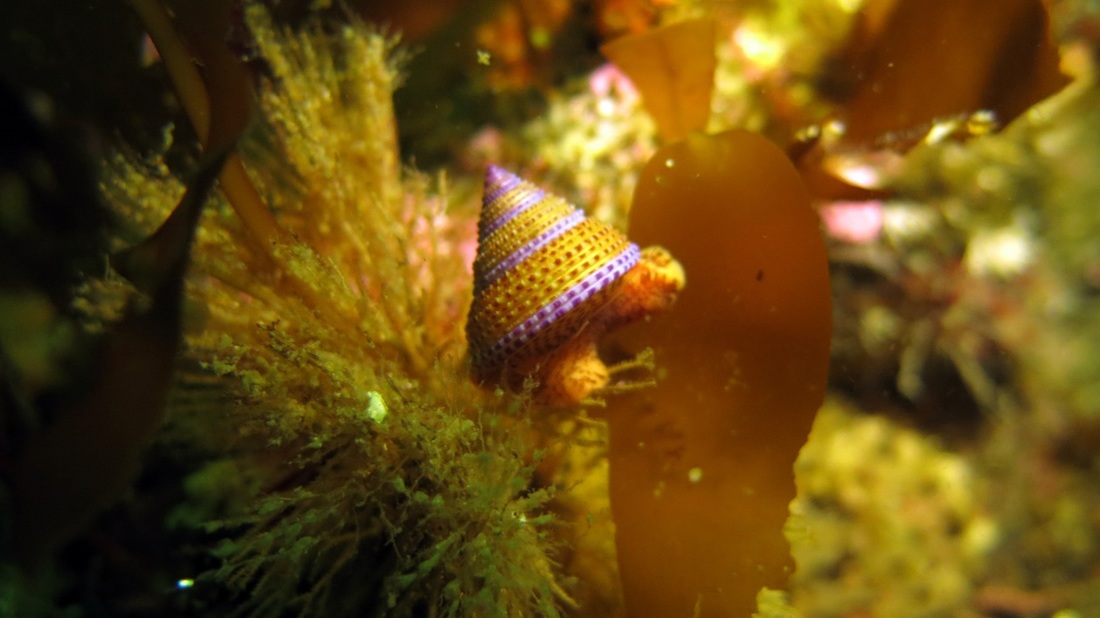Purple-ringed top snail • Calliostoma annulatum
Identification
The colourful shell of the purple-ringed top snail can be up to 30 cm tall. Shells typically have 8-9 whorls, each with a bright purple band that contrasts starkly with the rest of the orange-yellow shell. The spiral ridges are beaded (bumpy), and the snail’s soft body is pinkish-orange.
Similar Species
The brilliant colouration of the purple-ringed top snail is unlike any other Central Coast snail species. However, similarly shaped species such as C. variegatum and C. ligatum are distinguished by their lack of brilliant shell colour, and absence of beads on the spiral ridges (C. ligatum only). The soft body of C. variegatum is cream coloured, and that of C. ligatum is orange.
Habitat and Range
This vibrant species inhabits kelp forests – specifically the mid-stipe region of the kelp. The purple-ringed top snail can also be found on rocky shores in the exposed intertidal zone, to depths of 42 m. It can be found nestled among hydroids, feeding on kelp, or feasting on a diversity of algae and animals in the intertidal zone. Its range extends from northern Alaska to northern Mexico.
Intriguing Information
The purple-ringed top snail shares its kelp forest habitat with other top snails, such as C. ligatum and C. canaliculatum. However, each species inhabits a particular region of the kelp, with the purple-ringed top snail occupying the mid-stipe, C. ligatum the lower stipe, and C. canaliculatum the upper canopy.
This species feeds on kelp, encrusting diatoms, bryozoans, hydroids as well as detritus..
The colourful shell of the purple-ringed top snail can be up to 30 cm tall. Shells typically have 8-9 whorls, each with a bright purple band that contrasts starkly with the rest of the orange-yellow shell. The spiral ridges are beaded (bumpy), and the snail’s soft body is pinkish-orange.
Similar Species
The brilliant colouration of the purple-ringed top snail is unlike any other Central Coast snail species. However, similarly shaped species such as C. variegatum and C. ligatum are distinguished by their lack of brilliant shell colour, and absence of beads on the spiral ridges (C. ligatum only). The soft body of C. variegatum is cream coloured, and that of C. ligatum is orange.
Habitat and Range
This vibrant species inhabits kelp forests – specifically the mid-stipe region of the kelp. The purple-ringed top snail can also be found on rocky shores in the exposed intertidal zone, to depths of 42 m. It can be found nestled among hydroids, feeding on kelp, or feasting on a diversity of algae and animals in the intertidal zone. Its range extends from northern Alaska to northern Mexico.
Intriguing Information
The purple-ringed top snail shares its kelp forest habitat with other top snails, such as C. ligatum and C. canaliculatum. However, each species inhabits a particular region of the kelp, with the purple-ringed top snail occupying the mid-stipe, C. ligatum the lower stipe, and C. canaliculatum the upper canopy.
This species feeds on kelp, encrusting diatoms, bryozoans, hydroids as well as detritus..
References
Cowles, D. (2002). Calliostoma annulatum Invertebrates of the Salish Sea. Rosario Beach Marine Laboratory. Accessed 04/11/2015.
Harbo, R. M. (1997) Shells & Shellfish of the Pacific Northwest. Madeira Park, BC: Harbour Publishing. P.193
Hydroid. (2015). In Encyclopædia Britannica. Retrieved from https://www.britannica.com/animal/hydroid-hydrozoan
Jeweled top snail. Monterey Bay Aquarium. Monterey Bay Aquarium Foundation. Accessed 2015-10-29.
Lamb, A., and Hanby, B. (2005). Marine Life of the Pacific Northwest [electronic version]. Madeira Park, BC: Harbour Publishing.
Cowles, D. (2002). Calliostoma annulatum Invertebrates of the Salish Sea. Rosario Beach Marine Laboratory. Accessed 04/11/2015.
Harbo, R. M. (1997) Shells & Shellfish of the Pacific Northwest. Madeira Park, BC: Harbour Publishing. P.193
Hydroid. (2015). In Encyclopædia Britannica. Retrieved from https://www.britannica.com/animal/hydroid-hydrozoan
Jeweled top snail. Monterey Bay Aquarium. Monterey Bay Aquarium Foundation. Accessed 2015-10-29.
Lamb, A., and Hanby, B. (2005). Marine Life of the Pacific Northwest [electronic version]. Madeira Park, BC: Harbour Publishing.
Authors and editors of page
Beatrice Proudfoot (2015)
Beatrice Proudfoot (2015)




